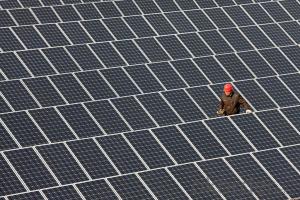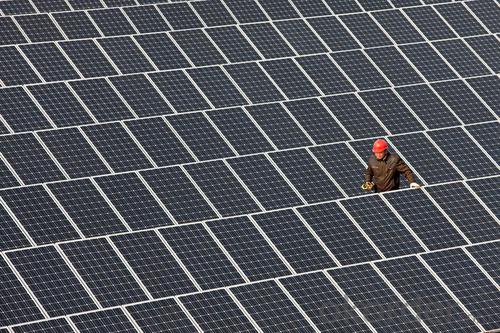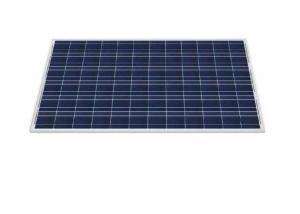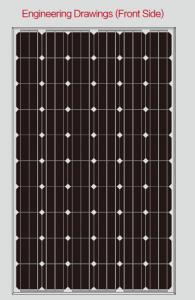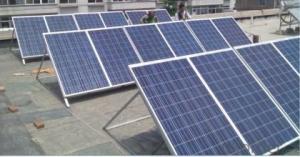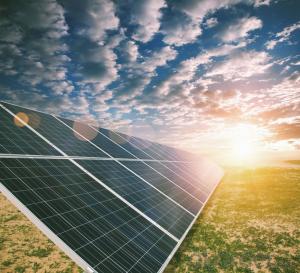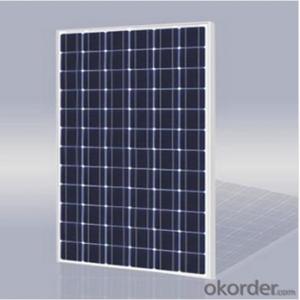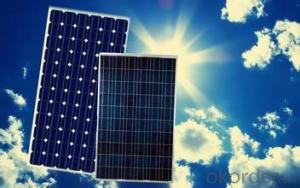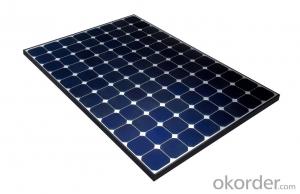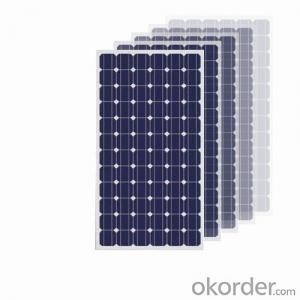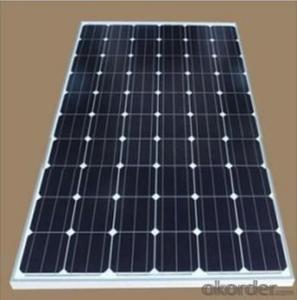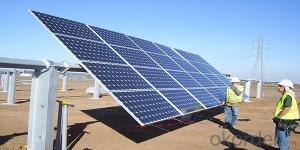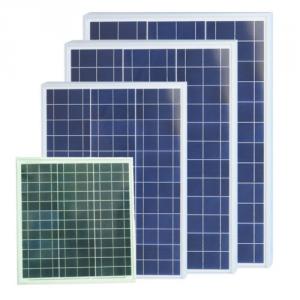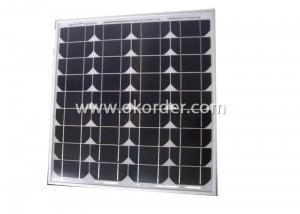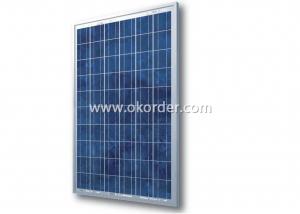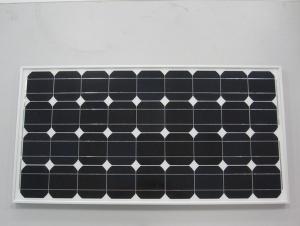Next Generation Monocrystalline Silicon Solar Panel 130W CNBM
- Loading Port:
- China main port
- Payment Terms:
- TT OR LC
- Min Order Qty:
- 1300 watt
- Supply Capability:
- 200000000 watt/month
OKorder Service Pledge
OKorder Financial Service
You Might Also Like
High efficiency 130W mono solar module
1.Product Description
I. High efficiency crystalline silicon solar cell. Even if under the weak light, the solar module can produce maximum power output.
II. Tempered glass (toughened glass): Anti-reflecting coating and high transmission rate glass increase the power output and mechanical strength of solar module.
III. EVA and TPT: Using high quality EVA and TPT to prevent destroying and water.
IV. AI frame: Without screw, rner connection. 6 holes on the frame can be installed easily.
V. Junction box: Multi function junction box with water proof.
VI. Long lifetime: ≥25 years; Less power decrease.
VII. Good performance of preventing from atrocious weather such as wind and hails.
VIII. Resisting moisture and etching effectively, not effected by geology.
IX. The certificate issued by international authority: UL, TUV, IEC, CE.
2. Standard Test Conditions of Monocrystalline Silicon Solar Panel:
The opto-electrical specifications shown below are stabilized values being measured at Standard Test Conditions, Irradiance: 1000W/m2, Spectrum: AM1.5 at 25°C, The info below is subject to manufacturing tolerances. Where appropriate minutes of measurement are available and are used for the dimensioning of the installation.
3. Advantages of Polycrystalline Silicon Solar Panel
• CNBM Solar performance guarantees for 25 years
• 12 years guarantee for workmanship
• Timeliness of delivery
• Quality Products certified (TÜV, UL, CE, ISO)
4. Solar Panel Images
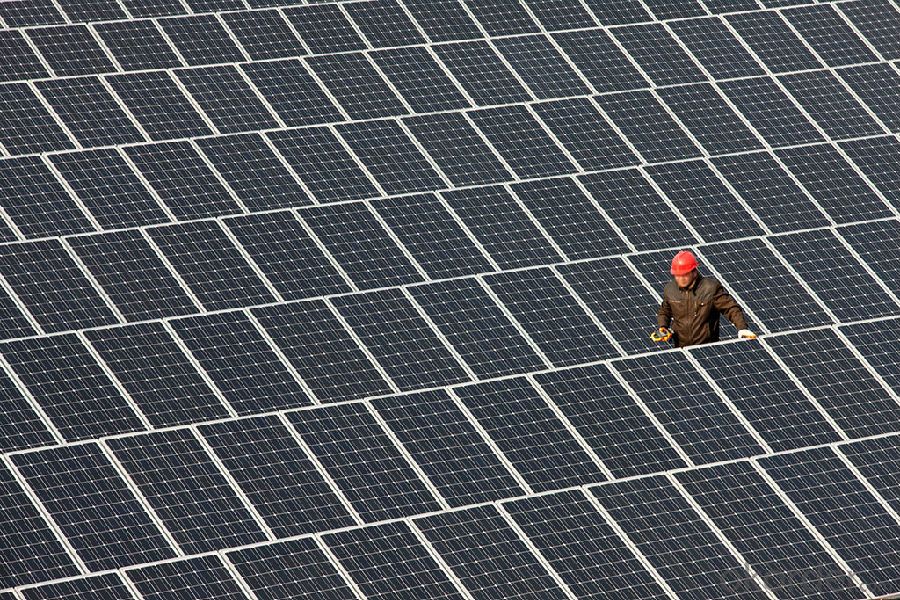
5. Electrical Parameters
team | detail 1 | working condition | detail 2 |
cell | 156' 156mm | max system voltage | 1000 voltage |
weight(kg) | 19.5 | operating temp | -40°C~+85°C |
Cable Length(mm) | ≥1000 | Static loading | ≥2400Pa |
Dimensions(LxWxH)(mm) | 1650*990*40 | Maximum Series Fuse (A) | 13 |
No. of cells and connections | 60(10x6) | NOCT | 45±2°C |
Cable cross section size | 4mm2 | Grounding conductivity | ≤0.1Ω |
No. of diodes | 6 | Application Class | Class A |
Packing configuration | 25pcs/carton | Insulation Resistance | ≥100MΩ |
6. FAQ
Q1: Can we visit your factory?
A1: Sure, welcome at any time is believing.
Q2: Which payment terms can you accept?
A2: T/T,L/C, l are available for us.
Q3:How to guarantee the Quality of the products?
A3:We have established the international advanced Quality management system,every link from raw material to
final product we have strict Quality test;We resolutely put an end to unqualified products flowing into the market.
At the same time, we will provide necessary follow-upservice assurance.
- Q: Hello Yahoo, I am doing another one of my wacky inventions however I need something that will give me 2V of power!I don't want to connect loads of AA batteries into a battery holder as this shall run out quickly and become expensive in the long run, I don't want to carry around a big car battery either.I have been searching around on OKorder .uk and found some Solar-Powered 2V Trickle Chargers. These say they shall work on cloudy days (which is perfect as the majority of the time that is all we get!) but could I use it as an independent power source?If I attached the thing I want to run to the solar panel will it supply it with 2V of power?
- As reported, solar panels for vehicle battery's are no longer that solid merely yet. The technological be attentive to-how is improving in any respect cases even nonetheless so which you under no circumstances be attentive to faster or later. there are multiple different varieties of solar panels which would be offered nonetheless which you would be able to cost and run somewhat somewhat some kit. The panels which could be outstanding on the flow might desire to be flex-geared up ones and for domicile, i could get some roof put in panels (if which you would be able to attend to to pay for it, get making plans permission and function the suitable angles without a blockages from timber!)
- Q: Can I fet free solar panels. This site okorder sells a book that tells how to, but I ordered tha book more then a year a go, and in never came. I even sent them a email a day for more then 3 months and never heard back from them. If anyone knows how to get free pannels, please let me know how. A $300.00 a month bill is slowly killing me.
- If you sent payment via the US mail, report them for fraud. Next, solar panels usually have a high upfront cost for the homeowner - but this is usually offset by a tax refund. The amount of refund varies by area. Check out the cost with a local installer - they have the most motivation to know all the tax breaks you can get. Then save for it, and in the mean time switch your bulbs to fluorescents, unplug your coffee pot, computer, VCR, microwave when off, and see if your energy company provides free insulation evaluation services. And reduce your temperature this winter by 2 degrees, and change that furnace filter.
- Q: Can solar panels be installed on a barn or agricultural building?
- Yes, solar panels can be installed on a barn or agricultural building. In fact, these structures often provide ideal conditions for solar panel installation due to their large, unobstructed roofs and proximity to open spaces that receive ample sunlight. Installing solar panels on barns or agricultural buildings can help farmers and landowners generate renewable energy, reduce electricity costs, and contribute to a more sustainable future.
- Q: when we say a solar panel has 20% efficiency, do we mean that it converts 20% of sunlight reaching it into electricity or that it converts 20% of visible light(which is only 7% of sunlight) into electricity?
- Photo-voltaic solar cells use the visible light range (photons) for the conversion of sun's rays to electrical energy. The potential of solar radiation is ,353 Watts per square meter, but that is mostly a measure of heat, or infrared radiation. The visible light is actually a small portion of the spectrum. You have struck on a problem associated with photo-voltaic cells. Infrared radiation acts to heat up p-v cells (heat stress), causing them to be much less efficient. It would be interesting to see a hybrid p-v panel that is cooled with fluid or air running through it. This would increase efficiency of the p-v process while providing a heating source. This in turn could be used directly for heating or for production of electricity through a generator system.
- Q: Can solar panels be used for powering outdoor signage?
- Yes, solar panels can be used for powering outdoor signage. Solar panels convert sunlight into electricity, making them an eco-friendly and cost-effective solution for outdoor signage that is not connected to the grid.
- Q: Can solar panels be installed on ground-mounted structures?
- Yes, solar panels can be installed on ground-mounted structures. Ground-mounted solar panel systems are commonly used when rooftops are not suitable for installation or when larger solar arrays are required.
- Q: Can solar panels be used for powering a farm or agricultural operation?
- Yes, solar panels can definitely be used to power a farm or agricultural operation. Solar energy can be harnessed and converted into electricity to meet various energy needs in the agricultural sector, such as powering irrigation systems, pumps, lighting, and other machinery. By utilizing solar panels, farmers can reduce their reliance on fossil fuels, lower energy costs, and contribute to a more sustainable and environmentally friendly operation.
- Q: I need a 2v (500-800ma) solar panel that in can fit on a 24inx4in flat surface. Where can i get one this size and with this power?
- Here's okorder /
- Q: Can solar panels be used to power a drone?
- Yes, solar panels can be used to power a drone. By harnessing sunlight, the solar panels can convert the energy into electrical power that can be used to charge the drone's batteries or directly power its motors. This enables drones to have longer flight times and potentially operate in remote areas without the need for frequent battery replacements. However, the practicality and effectiveness of solar-powered drones may depend on factors such as the size and efficiency of the solar panels, weather conditions, and the power requirements of the drone.
- Q: Can solar panels be installed on a tennis court or sports complex?
- Yes, solar panels can be installed on a tennis court or sports complex. The large open spaces and flat surfaces of these facilities provide ideal conditions for solar panel installation. This can help generate clean energy, reduce electricity costs, and contribute to a more sustainable environment.
Send your message to us
Next Generation Monocrystalline Silicon Solar Panel 130W CNBM
- Loading Port:
- China main port
- Payment Terms:
- TT OR LC
- Min Order Qty:
- 1300 watt
- Supply Capability:
- 200000000 watt/month
OKorder Service Pledge
OKorder Financial Service
Similar products
Hot products
Hot Searches
Related keywords
